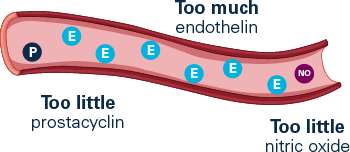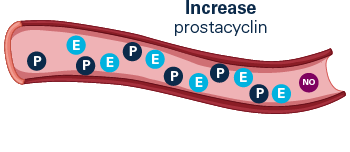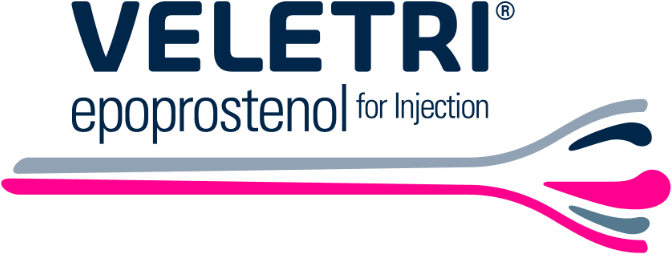How VELETRI® for Injection Works
With pulmonary arterial hypertension (PAH), you have less prostacyclin and nitric oxide, and too much endothelin. This imbalance causes your pulmonary arteries to become narrower over time.1

Pulmonary artery with PAH

PAH treated with VELETRI®
The active ingredient of VELETRI® is epoprostenol, which is a prostacyclin. VELETRI® works to add back the missing prostacyclin in PAH and open up the blood vessels in the lungs.2,3
VELETRI® has a half-life of approximately 6 minutes—meaning, within 6 minutes after the drug is absorbed, half the drug has already been used by the body or degraded.2 Because of this, VELETRI® cannot be given as a pill that can be swallowed. Instead, it must be continuously delivered intravenously (through a vein) through an intravenous (IV) line. This line is connected to a catheter (a very thin tube) that is placed into your heart.
Side Effects of VELETRI®
All medications affect each person differently. VELETRI® has side effects that must be routinely monitored by qualified medical personnel. Be sure to tell your healthcare professional about all of the medications you are taking before you begin VELETRI®.
Symptoms associated with starting treatment and dose increases3
Once you start VELETRI®, your healthcare professional may determine that you need a slight change in dose. Talk to your healthcare professional if you experience any of the symptoms below and have questions about them.
The most common side effects seen in at least 1% of patients were:
- Flushing
- Headache
- Nausea/vomiting
- Low blood pressure
- Anxiety/nervousness
- Chest pain
- Dizziness
- Slow heartbeat
- Abdominal pain
- Pain in the muscles and/or ligaments and bones
- Shortness of breath
- Back pain
- Sweating
- Upset stomach
- Numbness/increased sensitivity
- Fast heartbeat
Symptoms of too much VELETRI®3
You may also experience symptoms if there’s too much VELETRI® in your body. Talk to your healthcare professional if you experience any of the following symptoms:
- Flushing
- Headache
- Low blood pressure
- Fast heartbeat
- Nausea
- Vomiting
- Diarrhea
Most common side effects in people with PAH due to unidentified or hereditary factors3
During clinical trials, at least 10% more people in the group that received epoprostenol compared to the group that received conventional therapy* alone experienced the following symptoms:
- Flu-like symptoms
- Fast heartbeat
- Flushing
- Diarrhea
- Nausea/vomiting
- Jaw pain
- Pain in the muscles and/or ligaments and bones
- Anxiety/nervousness
- Dizziness
- Headache
- Numbness/increased sensitivity/tingling
Most common side effects in people with PAH due to connective tissue disease3
During clinical trials, at least 10% more people in the group that received epoprostenol compared to the group that received conventional therapy* alone experienced the following symptoms:
- Flushing
- Low blood pressure
- Lack of appetite
- Nausea/vomiting
- Diarrhea
- Jaw pain
- Neck/joint pain
- Headache
- Skin ulcer
- Rash
*Conventional therapy could include anticoagulants, oral vasodilators, diuretic agents, cardiac glycosides, and supplemental oxygen.3
Always inform your healthcare professional about any side effects you experience with your VELETRI® therapy. Your healthcare team is the best source of information for any questions or concerns you may have about your therapy or your condition.
References:
1. McLaughlin V. Pulmonary hypertension. In: Goldman L, Schafer AI, eds. Goldman’s Cecil Medicine. 24th ed. Philadelphia, PA: Elsevier Saunders; 2012:389-397. 2. McLaughlin VV, Archer SL, Badesch DB, et al. ACCF/AHA 2009 expert consensus document on pulmonary hypertension. J Am Coll Cardiol. 2009;53:1573-1619. 3. VELETRI® (epoprostenol) for Injection Full Prescribing Information. Actelion Pharmaceuticals US, Inc.
